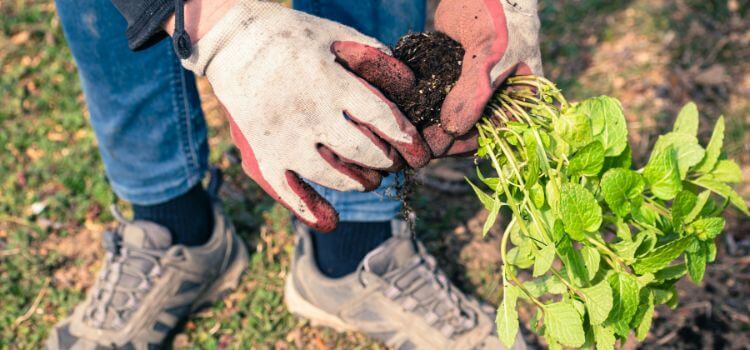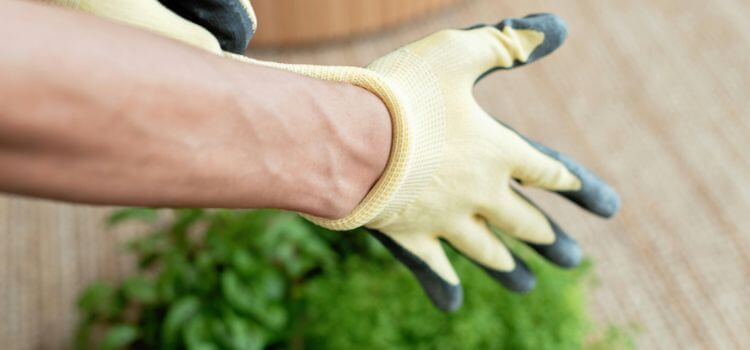As an Amazon Associate, I earn from qualifying purchases.
Gardening is a great way to enjoy nature and produce beautiful results. They protect our hands from dirt, thorns, and chemicals, yet we often forget how they protect us and deserve our care. We need to know how to wash gardening gloves.
Regular cleaning of your garden gloves keeps you safe from harmful bacteria and saves you money in the long run. However, different gloves require different cleaning methods due to their various materials and construction. Below is a detailed guide on washing garden gloves to ensure they remain safe.
The Importance of Maintaining Clean Garden Gloves
First and foremost, understanding the importance of clean garden gloves can change how you view their care. Besides looking suitable, clean gloves prevent bacteria and irritants that can cause dermatitis, fungal infections, and allergies. Gloves work better when clean to prevent dangerous substances from touching skin, food, or surfaces.
Filthy gardening gloves can harbour harmful microorganisms in the soil. Simple washes can remove these and prevent any transfer to your skin or items you touch.
Types of Garden Gloves
Before you wash your gloves, gather information about the type of gloves you have. Different materials require different handling during cleaning.
Gardening is a tactile experience that connects us to nature through the Earth’s soil, plants, and the elements. While often overlooked, suitable garden gloves can enhance your gardening experience. This guide will teach each glove feature, benefit, and best use.

Leather Gloves
Leather gloves have been a gardener’s favourite for eons, and for good reason. These gloves, made from cowhide, goatskin, or pigskin, offer a robust shield for your hands.
Features
- Durable and long-lasting
- Thorn-resistant
- Excellent grip, which improves with use
- Variety of fits and cuff lengths
Benefits
Leather gloves offer superior protection during challenging tasks, such as pruning rose bushes or handling abrasive materials. They also develop a personalized fit over time, becoming an extension of your hands.
Best Uses
Leather gloves are reliable for heavy-duty gardening tasks involving rough materials or sharp tools. They are suited to tasks needing a firm grip, such as digging with a spade or maneuvering heavy pots and containers.
Nitrile Coated Gloves
Nitrile-coated gloves have become increasingly popular among gardeners thanks to their versatility and comfort.
Features
- Water-resistant
- Flexible, providing good dexterity
- Excellent protection against chemicals
- Thinner and more lightweight than traditional rubber gloves
Benefits
These gloves are great for keeping your hands dry and protected in wet conditions. Their thinner profile easily allows finer tasks, like seeding or transplanting seedlings.
Best Uses
Nitrile-coated gloves excel in wet and delicate tasks, where protection against moisture and chemicals is equally essential. They are also a go-to for handling tools and watering, providing a balance of protection and precision.
Latex Gloves
Latex gloves are another popular choice, particularly for their elasticity and sense of touch.
Features
- Biocompatible
- Exceptional wet grip
- High sensitivity
Benefits
Gardeners who use water for weeding or pest control wear these gloves. Their sensitive nature makes them ideal for precision and delicate motor skills tasks.
Best Uses
Utilize latex gloves when planting or dealing with moist soil, as they offer outstanding wet grip properties. When handling small, delicate tasks that require good touch, such as sowing seeds or transplanting, reach for these gloves.
Neoprene Gloves
Neoprene gloves may be less well-known but essential for gardeners in cool or cold conditions.
Features
- Thermal insulation
- Resistant to creases, tears, and punctures
- Chemical resistance
- Excellent grip
Benefits
Their thermal insulation keeps hands warm without adding bulk. They keep hands warm and maintain tactile sensitivity, making them ideal for gardening in cooler months.
Best Uses
Neoprene gloves provide comfort and protection for cooler or wetter gardening. They are perfect for late fall or winter gardening tasks like harvesting cold-weather crops or preparing the garden for spring.
Cotton and Canvas Gloves
Simple in design yet effective, cotton and canvas gloves offer a breathable barrier for repetitive and lighter garden tasks.
Features
- Lightweight and breathable
- Stretchable for a customized fit
- Good for abrasion protection
Benefits
These affordable gloves protect hands during tasks that do not require heavy-duty protection. They are also excellent for keeping hands clean and maintaining a barrier against dirt and minor abrasions.
Best Uses
There are many uses for cotton and canvas gloves, such as planting, watering, and light weeding. Consider them for all non-hazardous tasks requiring a light layer of protection.
Nylon Gloves
Nylon gloves, often underappreciated, serve as the bridge between tactile needs and protective functions. They are the choice for gardeners tending to tasks that do not involve heavy thorns or chemicals but require skill. Nylon’s breathability lets your hands breathe while protecting them throughout extended, perspiring jobs. These gloves are ideal for sowing seeds, light weeding, and other chores where bare fingertips’ precise sensory wake would be beneficial.
The Upsides of Nylon Gardening Gloves
- Breathability: For tasks under the baking sun, nylon gloves allow air to circulate, preventing moisture build-up and maintaining comfort.
- Flexibility: The snug fit and flexibility ensure that hand movements are not impeded, which is crucial for detailed gardening tasks that require manual dexterity.
- Versatility: They are all-around gloves for various tasks in most garden environments.
Rubber Gloves
These gloves protect hands from wetness from rain-soaked soil or intense gardening. Rubber garden gloves, or “grippy gloves,” keep plants, hoses, and tools in place in slippery conditions. These gloves are best for handling wet garden products or chemicals.
The Benefits of Rubber Garden Gloves
- Waterproof: A fundamental requirement for handling wet, soggy garden conditions without your hands facing the consequences.
- Grip: Rubber gloves help grip slippery gardening surfaces.
- Protection: They safeguard hands against incidental or deliberate contact with chemicals, ensuring safety while handling fertilizers or pesticides.
You May Also Read This Article:
Top 10 Best Gloves for Handling Cactus in 2025
How To Use Garden Gloves With Claws
How To Wash Garden Gloves?
Now that you understand the variety of gloves, it’s time to take action and give your gloves the needed cleaning. We’ll cover the two main methods of cleaning: handwashing and machine washing.

Handwashing Your Garden Gloves
Handwashing is the gentlest method and is often recommended for delicate gloves.
Supplies Needed:
- Mild detergent
- A soft brush or cloth
- Warm water
Steps:
- Pre-Rinse: Begin by rinsing off any loose dirt or grime with plain water.
- Cleaning Solution: Mix the mild detergent with warm water in a clean bucket or sink.
- Scrubbing: Scrub the gloves with soapy water using a gentle brush or cloth, focusing on the dirtiest spots.
- Rinse: Thoroughly rinse the gloves with clean water to remove all suds and residual soap.
- Drying: Air dry the gloves by hanging or laying them flat in a well-ventilated area, away from direct sunlight or heat sources.
Machine Washing Your Garden Gloves
Machine washing can be quicker and more thorough but must be cautiously approached to prevent damage.
Supplies Needed:
- Gentle or handwashing detergent
- Mesh laundry bag for added protection
Steps:
- Pre-Treatment: Pre-rinse heavily soiled gloves to remove any excess dirt.
- Protection: The mesh laundry bag will keep the gloves while being washed.
- Choosing the Cycle: Select the gentle cycle on your washing machine with the water temperature as recommended for the glove material (usually cold or warm).
- Detergent: Add the appropriate amount of gentle detergent for the load size.
- Drying: Machine dry on a low-heat setting or air dry, depending on the glove’s care instructions.
Drying and Storing Your Garden Gloves
Properly drying and storing your garden gloves is as important as cleaning them. Mould and mildew overgrow on damp gloves, and incorrect storage can accelerate deterioration.
Drying:
- After handwashing, absorb as much water as possible without wringing the gloves.
- After machine washing, reshape the gloves and smooth any wrinkles before drying.
- Do not heat leather gloves—they can shrink and become brittle.
- Air-dry the gloves in a well-ventilated area until completely dry.
Storing:
- Once dry, store your gloves in a cool, dry place away from direct sunlight.
- If storing for an extended period, stuff the fingers with paper to help them retain their shape.
How to Choose the Best Garden Gloves for You
Selecting garden gloves is a highly personalized endeavour. Gardeners have different needs depending on task size, environment, and tastes.
If precision and skill are the mainstay, nylon gloves will likely serve you best. Rubber gloves are a must if moisture and chemicals are in the equation.
Is your garden an expanse of desert plants or a lush, water-demanding Eden? The climate and flora play a significant role in determining the most practical glove material for you.
Excessively tight gloves restrict movement and are unpleasant, while excessively loose gloves hinder precision activities. Fit snugly but comfortably to provide hand flexibility.
Frequently Asked Questions (FAQs) on How to Wash Garden Gloves
Most cotton and synthetic garden gloves are machine washable. Wash them on a gentle cycle with cold water, along with a mild detergent. Check your gloves’ care label for detailed directions since some materials require different care.
Leather garden gloves should not be machine-washed. Instead, gently hand wash them using a damp cloth and a mild soap. Apply a leather conditioner after washing to keep them supple. Consider a saddle soap for tougher stains, but test on a small area first.
It’s advisable to air-dry garden gloves, especially leather or specialty fabric gloves. If the care label says it’s safe, tumble dry machine-washable cotton and synthetic gloves on low heat. Air drying is the best option to maintain shape and fit.
Remove excess dirt by clapping gloves together or using a hose. Soak gloves in a pail of lukewarm water with detergent for thick soil for 30 minutes. Rinse thoroughly afterward. Avoid hot water, which can shrink or damage material.
Avoid using bleach on garden gloves, especially coloured or leather ones, as it can damage or discolour the fabric. Use diluted bleach sparingly to disinfect or remove stubborn stains from white, bleach-safe cotton gloves.
Wash your garden gloves regularly to remove dirt, bacteria, and chemicals from pesticides or fertilizers. If you use them often, wash them every 3-4 uses or weekly throughout the gardening season.
Conclusion
Our hands and our gardens deserve garden gloves that are in top condition. Now that you know how to clean your gloves properly, you can garden confidently.
Remember, gardening is a relationship with the Earth that we cultivate over time. Like caring for our garden beds, taking care of our tools and equipment, primarily our gloves, is stewardship.
Happy gardening, and may your gloves always be clean and ready for the next planting season.

